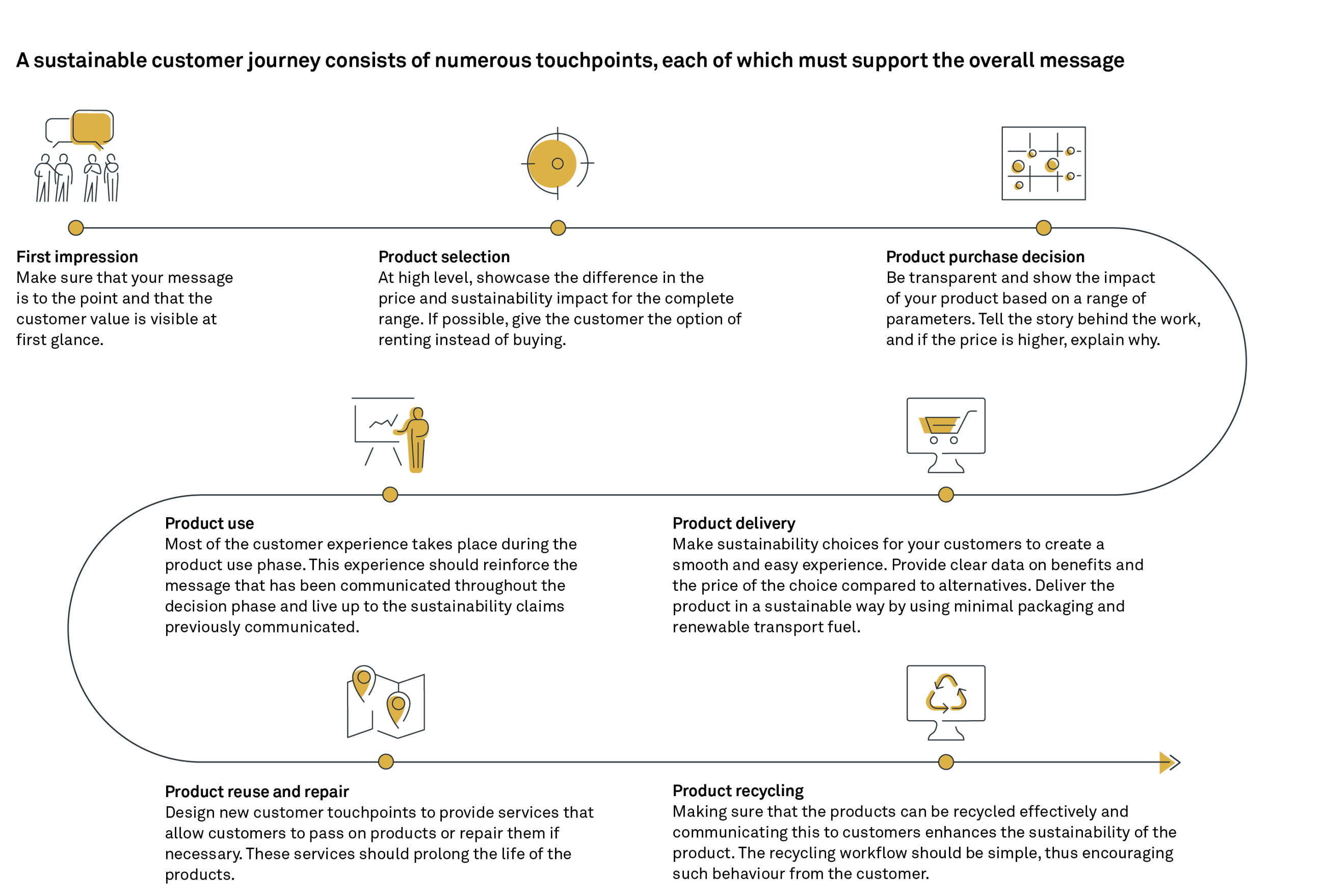– unlocking commercial value by leveraging the customer experience
21 June 2022
How do you effectively translate sustainability efforts into greater business value and customer satisfaction?
Many companies are working hard to improve their sustainability efforts, and some have come considerably further than their competitors. However, there are still very few companies that have successfully capitalised on improved sustainability performance. A common problem is that mere product attributes are not sufficient, as the entire customer experience is not perceived as more sustainable to the extent that it makes people willing to pay more. This results in sustainability initiatives in many companies being viewed as a cost rather than an investment.
Designing the customer experience with this in mind can be an effective means of translating your sustainability efforts into business value. This article outlines eight factors to consider when creating a customer journey with the potential to increase the perception of sustainability.
Our experience and market observations show that sustainability is becoming increasingly important when consumers make purchasing decisions. This results in companies facing pressure to develop sustainable solutions, making them a key part of their value proposition and ensuring that the entire customer journey meets the expectations of the customer.
Let us start with an example
A company producing outdoor products, with tents accounting for a large share of their revenue, is investing heavily in becoming more sustainable.
They were differentiating themselves from the competition by offering products that not only met the standard requirements for tents in terms of size and use, but were also manufactured to minimise their environmental impact. The materials used were either renewable or recycled. They were actively working on their upstream supply chain, with tier 1 suppliers using 100% renewable energy. Since 2017, the company has been on a journey that entails exchanging all transport fuels for renewable ones and has actively engaged in inspiring others to do the same.
But the effort and investments that the company put into making their products more sustainable were not reflected throughout their customer journey, leaving the company feeling that they were not creating business value in terms of their own metrics for success and value.
So where did it go wrong?
The one thing that left many customers disappointed was the lack of opportunity to repair items and buy spare parts, months or even years after making their purchase. This resulted in low scores on reviews coming in many months after the purchase had been made – something that in the company’s experience is a matter of growing concern for their brand as customers become more aware.
One lesson to be learned from the example is the importance of ensuring that the sustainable customer journey is truly sustainable from A to Z, and that there are no slip-ups at individual touchpoints that will undermine the entire experience for your customers.
The sustainable customer journey
Below is an example of the customer experience when buying a pair of jeans, using MUD Jeans as an example. At each touchpoint in the customer journey, we provide specific information on how MUD Jeans currently communicates, along with tips on what they can do to improve the customer experience.
Online customer journey example
To create a customer journey that reflects your sustainability initiatives, it is critical that, when designing all touchpoints, you focus on the impression you want to give your customer. This may be challenging but based on our experience, we have identified eight factors you need to consider when designing your sustainable customer journey:
- Understand the short- and long-term needs and preferences of the relevant customer segments and markets by conducting qualitative surveys, as well as by studying market trends and behavioural patterns. When it comes to sustainability aspects, make sure you analyse and understand their areas of interest and their willingness to pay with respect to these. This provides sound guidance for customer experience design – where you should pay special attention and where you should invest additional resources. Check whether attractive customer segments that have previously been unreachable can be won in the future through a more sustainable value proposition and how this can be achieved. This may include offering a rental model that enables a much larger number of people to afford your products or making your products available to customers for the first time.
- Map the key touchpoints that are most important for the overall customer experience or the buying decision. Focus on making these touchpoints and how they are perceived as sustainable as possible. Prioritise one or two positive peaks over mediocrity across all touchpoints. However, despite prioritising one or two touchpoints, do not jeopardise the overall experience by neglecting sustainability in other touchpoints (as in the first customer example).
- Find new, circular touchpoints as the world and business make the shift towards a more circular economy. Identify the new customer touchpoints created by the shift from a linear to a circular business model, and where you can play in the future. To create an experience in line with this, your customers must be able to reintegrate their used products in the economic cycle. You benefit the most when your company creates these opportunities itself. For example, you can provide your customers with a venue, tools and know-how to enable them to repair their products themselves. Another possibility is to give customers the opportunity to return their products after use so they can be remanufactured or provide a platform through which customers can sell products they no longer use. Lastly, you can opt for a business model with greater life cycle responsibility, either a rental model or a complete “as-a-service” offering, where customers primarily pay for utility. This usually ensures that commercial and sustainability considerations are better aligned, thus incentivising increased sustainability and mitigating financially constraints. These models not only enable more sustainable customer experiences, they also offer the possibility of deeper customer relationships and higher customer lifetime values as a result.
- Strive towards full transparency in relation to your customers. Create trust by being transparent about what you know and what you do not know, about what you have done and still intend to do. Bring your customers along on the transformation journey and make the information simple and easily accessible. Link communication to the needs you have already identified in your customers and build trust by transparently sharing product sustainability performance data. For B2B companies, this can serve as a starting point for co-developing new solutions.
- Find and leverage digital tools to enhance the sustainability of your offering and amplify the desired customer experience. Technology can improve the customer experience in several dimensions where perception and satisfaction are concerned, but also in terms of the fundamental value proposition and improved products. One important example is how the use of digital tools can increase circularity. By creating pleasant and uncomplicated digital interfaces that enable and encourage customers to engage in inverse logistics, i.e., various forms of reuse/recycling, you can achieve greater sustainability and satisfaction at the same time. This can lead to greater customer loyalty and better brand associations, ultimately delivering higher profitability.
- Use your ecosystem to create a more comprehensive and sustainable offering. Use partnerships in the delivery, use and end of life of your product or service. You need to look beyond the boundaries of your own company when designing a sustainable customer journey. Identify up- or downstream partnerships that can add value to your offering, increase its sustainability or enhance the desired sustainable customer experience. These partnerships may include online retailers, fossil-free couriers, repair service providers and co-investments in recycling infrastructure and capability.
- Develop organisational readiness and capabilities to ensure you send a genuine and convincing sustainability message to customers. The experience must be consistent throughout the journey and, therefore, across all touchpoints with human interactions. To be able to sell value efficiently, your salespeople must be trained in how your sustainability efforts fit into the overall value proposition. The same applies to all other employees who have contact with customers, e.g., employees in logistics, finance or aftermarket. In addition, to achieve major customer-centric sustainability capabilities, it is necessary to change the conversation regarding sustainability in your company, ideally ensuring that sustainability is deeply reflected in the company’s vision and culture.
- Develop incentives to nudge customer behaviours and accelerate sales and impact. Educate customers and build in incentive models to nudge them towards the more sustainable options. Bear in mind the differences in culture and maturity in different markets when communicating the value of your products and services, for example. If customers are offered different alternatives, make sure the sustainable ones are attractively incentivised in some way.
Want to accelerate your initiatives aimed at creating a more sustainable future?
We need to start accelerating more sustainable solutions and making them easily accessible to the majority. At Implement, we help companies translate their sustainability efforts into greater competitiveness and customer satisfaction. Very often, this journey starts with understanding the needs of your customers and what creates value for them, enabling you to truly combine sustainability initiatives with your commercial strategy and its execution.
Related0 4
Create a superior customer experience
How a customer-centric culture can give you a competitive advantage.Acting customer-centric in difficult times
How to adapt your business to a world with new customer needs and expectations.Let dreams grow your business
Combining company and customer visions to create a sustainable world.Want to know more?
If you would like to discuss what this could look like for your company, please contact us.






